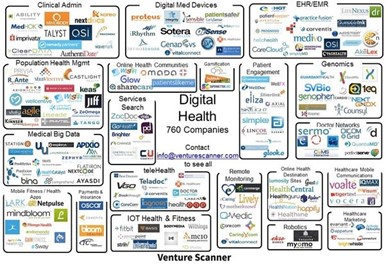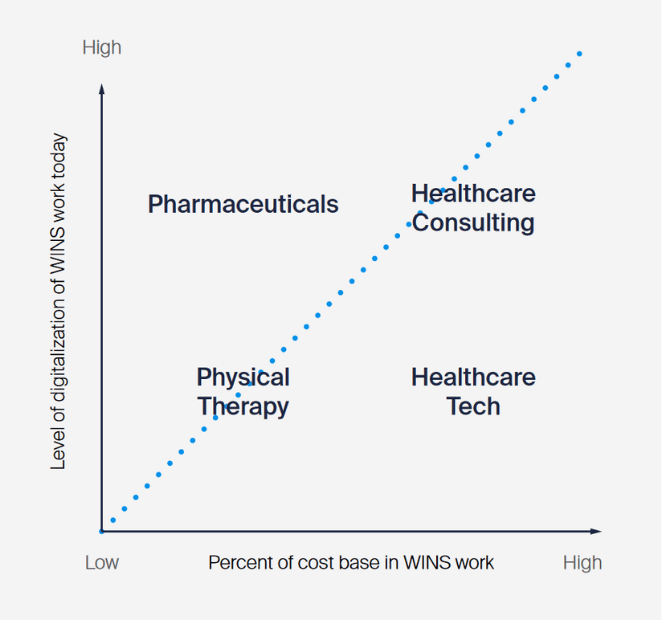Sourcescrub and Grata are joining forces to deliver the market’s most complete market intelligence platform
Learn more

Generative artificial intelligence (GenAI) is a transformative technology that will upend industries. We know generically that it will impact “knowledge workers,” but such a broad piece of wisdom isn’t very helpful for understanding its potential effects on specific industries or companies — especially in highly fragmented and complex markets.
Understanding how various sectors, sub-sectors, and even specific businesses will be impacted by this game-changing advancement is critical for dealmakers to effectively determine which opportunities are ripe for disruption, which offer unique value creation opportunities, and which may be headed for extinction.
The WINS framework, introduced in a recent Harvard Business Review article titled Where Should Your Company Start with GenAI (published on 9/11/23), can be used to objectively measure the impact of and potential for applying GenAI in certain industries.
Health-related products and services now account for over 18% of total US GDP, and post-COVID concerns, the aging Baby Boomer generation, increased mental health awareness, and recent scientific and technological advancements continue to make healthcare one of the fastest growing industries in the world. Conditions are driving unprecedented innovation and potential.
But healthcare is massive and highly fragmented, with at least 6 core sectors and sub-sectors that include everything from hospitals, digital health, and dental services to alternative medicine, medical research, and healthcare consulting. The digital health sub-sector alone features more than 760 companies that are categorized even further by telemedicine, genomics, remote monitoring, and more.

This market fragmentation enables dealmakers to create competitive advantage through specialization and proprietary sourcing. But it also makes it extremely difficult to know precisely where to place bets.
Although developed to identify the easiest ways for companies to get started with GenAI, the WINS framework can also be used to objectively understand the areas where GenAI is likely to cause the most disruption. WINS stands for “Words, Images, Numbers and Sounds” – the things GenAI is most capable of automating.
WINS work refers to the places where tasks, functions, or even an entire company or industry rely on the manipulation and interpretation of Words, Images, Numbers, and Sounds. Generating copy, computer code, images, narration, music, or videos, as well as ingesting and summarizing, critiquing, improving, or reformatting almost any kind of document or analysis are all examples of WINS work.
By adapting models like the WINS framework to understand where GenAI is most likely to have the biggest impact based on WINS work, dealmakers can begin to look at deals differently.
In the past, dealmakers would develop an investment thesis built on ways target companies could maximize EDBITA margin. Typically, this means improving economics by streamlining sales, finance, and operations along with ways to drive scale or market expansion.
In a recent webinar on the past, present, and future of AI, John Shaw, AI entrepreneur and CEO of Value Add Machine, discussed how AI can help maximize EBITDA. In every deal, he suggested you should now ask, "What could an AI model do to reduce resource consumption?"
He pointed to AWS QuickSight, an AI-driven business intelligence (BI) service that analyzes and visualizes data from multiple sources, as a way for a company's data analysts to focus on more impactful tasks than simply generating reports. Or, perhaps with a code-generating AI model, engineering costs could be reduced or reallocated.
Investors can now also look beyond efficiency for ways GenAI can create brand new sources of product or service value. For example, previously undervalued assets like data from failed clinical trials could now be the reason to pursue a deal. In pharmaceuticals, AI-assisted research may be able to help create new drugs based on what might have been considered dead data.
This potential allows dealmakers to consider new questions that will help guide their sourcing and investment decisions, including:
To understand the potential impact of GenAI on a particular industry, dealmakers can score and plot sectors or sub-sectors based on two dimensions:
Based on the below example, you can conclude that an industry like Healthcare Consulting, with a large number of WINS-related roles and high degree of digitization, has great potential for performance improvements as roles are enhanced or replaced by GenAI capabilities. In contrast, physical therapy, with much fewer WINS-related roles and a lower level of digitization, has far less potential for dramatic GenAI-related performance improvements.

WINS can also be used to quantify the potential impact of GenAI on a specific set of companies to then score them and rank value potential. By looking at employee headcount by occupation, you can create a scoring model based on a company’s aggregate exposure to WINS-related impact. One approach would be to use occupation data from a source like LinkedIn, which has headcount estimates by role and skills.

There is also public data from studies like Oxford University’s research on the future of work that looked at the susceptibility of specific jobs to digitization. Their research categorizes and scores 702 occupations according to their potential for automation.
A recent experiment to quantify the productivity gains of GenAI was conducted at Boston Consulting Group. They looked at 18 different tasks designed to mimic real work performed at a top-tier consulting company.
The consultants who utilized ChatGPT-4 significantly outperformed those who didn't across every category and method of measuring productivity. On an average, consultants using AI completed 12.2% more tasks, accomplished tasks 25.1% faster, and generated 40% higher quality results.
GenAI is here, and it promises to both create and destroy company value. Dealmakers who are able to objectively predict and measure the impact are going to outperform, particularly in complex and highly competitive industries like healthcare. To learn more about how leading dealmakers are leveraging creative strategies like WINS to find and close more deals now, download this guide.